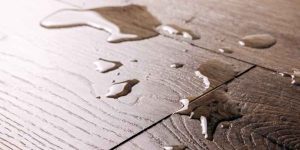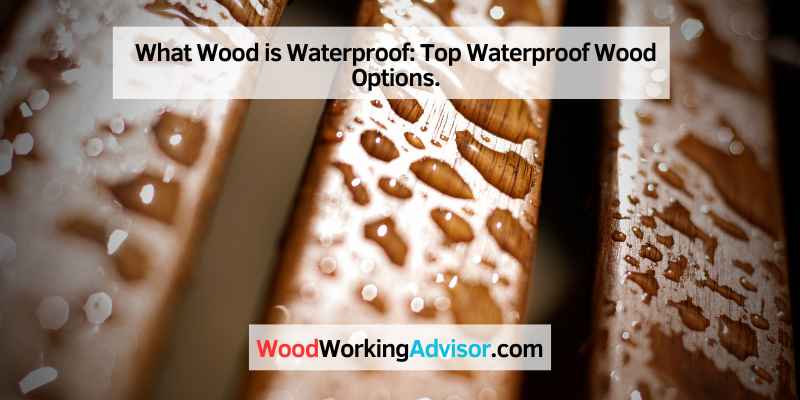Ipe wood is naturally waterproof, making it an excellent choice for water resistance. Known for its exceptional durability and high weather resistance, Ipe wood is highly renowned in the industry.
When it comes to finding wood that is waterproof, Ipe wood takes the lead. With its natural water resistance properties, it is an ideal choice for outdoor applications. The name “Ipê” in Tupi, meaning “hard shell,” reflects its exceptional durability.
Ipe wood is highly renowned for its high weather resistance, making it a top choice for those seeking waterproof wood options. Its ability to withstand moisture and maintain its integrity over time makes it a popular choice for decks, outdoor furniture, and other water-exposed areas.
Factors Affecting Wood Water Resistance
When it comes to determining the water resistance of wood, several factors come into play. Understanding these factors can help you choose the right wood for your outdoor projects. Two key factors that affect wood water resistance are natural oils and acids, as well as density and moisture barrier.
Natural Oils And Acids
Some wood species have natural oils and acids that contribute to their water resistance. These substances act as a protective barrier, preventing water from penetrating the wood fibers and causing damage.
| Wood Species | Natural Oils and Acids |
|---|---|
| Ipe wood | High concentration of natural oils |
| Teak | Contains natural oils and silica |
| Redwood | Contains natural acids |
These wood species, among others, are highly resistant to rot and decay due to their natural oils and acids. Their water resistance makes them suitable for outdoor applications such as decking, furniture, and siding.
Density And Moisture Barrier
Another important factor affecting wood water resistance is density and the presence of a moisture barrier. Denser woods tend to have smaller pores, which makes it harder for water to seep in.
Some wood species that are known for their density and moisture barrier include:
- Maple
- Cherry
- Black locust
These woods have a high resistance to moisture and are popular choices for outdoor projects that are exposed to the elements.
In addition to natural oils and density, the moisture content of the wood also plays a role in determining its water resistance. Wood with low moisture content is less likely to absorb water.
While these factors contribute to the water resistance of wood, it’s important to note that no wood is completely waterproof. Proper maintenance and regular sealing or coating are still necessary to ensure the longevity of outdoor wood projects.
Top Water-resistant Wood Types
Water-resistant wood is a crucial choice for outdoor projects due to its ability to withstand moisture and harsh weather conditions. Here are some top water-resistant wood types:
Ipe Wood
Ipe wood is known for its exceptional durability and high weather resistance. Derived from the name “Ipê,” meaning “hard shell” in Tupi, this wood is a popular choice for its longevity and strength.
Teak
Teak wood is highly regarded for its natural oils that make it resistant to decay and rot. It is a sought-after wood type for outdoor furniture and marine applications due to its durability and water resistance.
Red Cedar
Red Cedar contains natural oils and acids that resist decay, making it one of the most rot-resistant wood types. It is commonly used for outdoor projects like decking and siding due to its durability.
Iroko
Iroko wood is an African hardwood known for its excellent dimensional stability and resistance to warping in moisture. It is a popular choice for outdoor projects that require a water-resistant wood type.
Oak
Oak wood is renowned for its strength and durability, making it a reliable choice for outdoor applications. It has natural water-resistance properties that make it suitable for various outdoor projects.
Cumaru
Cumaru wood is a dense and durable wood type with natural resistance to water and decay. It is often used in outdoor decking and siding due to its longevity and low maintenance requirements.
Properties Of Water-resistant Wood
Dimensional Stability
Water-resistant wood, such as Iroko and Oak, exhibit exceptional dimensional stability when exposed to moisture. These species maintain their shape and size, reducing the risk of warping or shrinking.
High Resistance To Warping And Shrinking
Hardwoods like Western Red Cedar and Cherry boast high resistance to warping and shrinking, ensuring durability even in moist environments. This characteristic makes them ideal for outdoor applications.
Applications Of Water-resistant Wood
Water-resistant wood is a versatile material that can be used in various applications, especially in outdoor settings where exposure to moisture is a concern. Let’s explore some common applications of water-resistant wood:
Decking
When it comes to decking, water-resistant wood like Ipe and Teak are the top choices due to their exceptional durability and rot-resistant properties. These hardwoods can withstand outdoor elements, making them ideal for long-lasting and low-maintenance decking solutions.
Marine Plywood
Marine plywood is specially designed for water-based applications and for use in marine environments. It is typically made from durable wood species like Western Red Cedar and Teak, known for their natural resistance to moisture and decay. Marine plywood is commonly used for boat building and other water-related projects.
Outdoor Furniture
For outdoor furniture that needs to withstand changing weather conditions, water-resistant wood such as Oak, Maple, and Cherry are excellent choices. These wood types offer high dimensional stability and resistance to warping and shrinking when exposed to moisture, making them perfect for durable and long-lasting outdoor furniture pieces.
Maintenance Of Water-resistant Wood
When it comes to using water-resistant wood in outdoor settings, it’s essential to understand the proper maintenance to prolong its durability and performance. By adopting the right maintenance strategies, you can ensure that your water-resistant wood remains in optimal condition for a long time. Here are the key maintenance practices:
Cleaning
To maintain the water-resistance of the wood, regular cleaning is crucial. Sweep away dirt, debris, and leaves to prevent moisture buildup. Use a mild soap solution and a soft-bristled brush to remove stains and grime without damaging the wood’s surface. Rinse thoroughly with water and allow the wood to dry completely before further treatment.
Sealing
Sealing the wood is a vital step in preserving its water-resistance. Apply a high-quality wood sealer or waterproofing agent to create a protective barrier against moisture intrusion. Ensure the entire surface is evenly coated, paying special attention to seal any cracks or exposed areas. Regularly check the sealant for wear and reapply as necessary.
Regular Inspections
Regular inspections are essential for identifying any signs of wear, damage, or potential water penetration. Inspect the wood for cracks, warping, or discoloration, which may indicate water-related issues. Promptly address any defects to prevent further deterioration and maintain the wood’s water-resistance.
Comparison With Traditional Wood
When it comes to choosing the right wood for outdoor structures or areas with high moisture levels, it’s essential to consider waterproof wood as a superior option compared to traditional wood. This comparison helps to highlight the distinct features that make waterproof wood a preferred choice for durability and longevity.
Wicking Of Water
The wicking of water in traditional wood leads to high levels of absorbency, causing swelling and warping over time. On the other hand, waterproof wood has low wicking properties, preventing water absorption and minimizing the risk of damage due to moisture.
Decay Resistance
Traditional wood is prone to decay and rot when exposed to moisture, resulting in a shorter lifespan. In contrast, waterproof wood exhibits high resistance to decay, thanks to its natural oils and acids that effectively inhibit biological deterioration, ensuring longevity even in wet environments.
Myths And Misconceptions
Ipe wood is known as the top choice for water resistance due to its exceptional durability and high weather resistance. Other rot-resistant and water-resistant woods include teak, redwood, Western Red Cedar, and oak. They all have excellent dimensional stability and resistance to warping and shrinking in the face of moisture.
Waterproof Vs. Water-resistant
In our quest for finding wood that can withstand water damage, it’s important to understand the difference between waterproof and water-resistant. Many people use these terms interchangeably, but they have different meanings.
Waterproof wood refers to a material that is completely impervious to water. It does not absorb any moisture and remains unaffected even when exposed to water for extended periods. On the other hand, water-resistant wood is capable of resisting water to a certain extent, but it is not completely impervious. It may still absorb some moisture over time, although at a slower rate than other types of wood.
The Role Of Finish
One common misconception about water resistance in wood is that the type of wood alone determines its waterproof qualities. While some woods naturally have better water resistance than others, the finish applied to the wood plays a significant role in enhancing its ability to repel water.
A protective finish acts as a barrier, preventing moisture from seeping into the wood fibers. It creates a waterproof layer that shields the wood from rain, humidity, and other sources of water. A high-quality finish can significantly extend the lifespan of wood that is not naturally waterproof.
It’s essential to choose the right finish for your specific application. Some common types of finishes for waterproofing wood include polyurethane, varnish, and epoxy. These finishes provide an additional layer of protection and help maintain the integrity of the wood over time.
Conclusion
To sum up, understanding the difference between waterproof and water-resistant wood is crucial. While some woods naturally have better water resistance, the application of a suitable finish can further enhance their ability to withstand water damage. By dispelling the myths and misconceptions surrounding water resistance in wood, we can make informed choices and select the right materials for our projects.

Frequently Asked Questions On What Wood Is Waterproof
What Wood Is Naturally Waterproof?
Ipe wood is naturally waterproof, making it a top choice for water resistance due to its exceptional durability and weather resistance. Other rot-resistant woods include teak, redwood, cypress, and the heartwood of Western Red Cedar. Additionally, heat-treated woods like Iroko, Oak, and Maple offer excellent water resistance and dimensional stability.
What Is The Most Weatherproof Wood?
“Ipe wood is the most weatherproof due to its high water resistance and exceptional durability. Other rot-resistant woods include teak, redwood, and cedar. Hardwoods like ipe and teak are highly durable and can last for decades outdoors with minimal maintenance.
What Wood Is Most Rot-resistant?
The most rot-resistant wood is the heartwood of Western Red Cedar, known for its natural oils and acids that resist decay.
What Type Of Wood Is Good For Water?
Ipe wood is a top choice for water resistance due to its exceptional durability. Other good options include teak, redwood, cedar, and cypress. These woods are highly rot-resistant and can last for decades with minimal maintenance.
Conclusion
When it comes to wood that is naturally waterproof, Ipe wood stands out as a top choice. Its exceptional durability and high weather resistance make it a popular option. Other hardwoods such as teak also have excellent rot-resistant properties, making them ideal for outdoor use.
Additionally, woods like Iroko, Oak, and Western Red Cedar exhibit dimensional stability and high resistance to warping and shrinking when exposed to moisture. Choosing the right water-resistant wood type ensures longevity and minimal maintenance for your projects.


